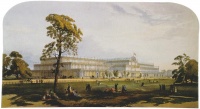Modern
From The Art and Popular Culture Encyclopedia
(Difference between revisions)
| Revision as of 14:00, 3 April 2013 Jahsonic (Talk | contribs) ← Previous diff |
Revision as of 14:42, 3 April 2013 Jahsonic (Talk | contribs) Next diff → |
||
| Line 1: | Line 1: | ||
| - | [[Image:The Crystal Palace.jpg|thumb|right|200px|The usage of new materials such as [[iron]], [[steel]], [[concrete]] and [[glass]] is ascribed an important place in [[modern architecture]], with [[the Crystal Palace]] of [[1851]] considered as its first large scale use.]] | ||
| [[Image:Trylon, Perisphere and Helicline (Samuel H. Gottscho).jpg|thumb|200px|The [[Trylon and Perisphere]], two [[Modernist architecture|modernistic structures]] at the [[1939 New York World's Fair|New York World's Fair of 1939-1940]]<br> | [[Image:Trylon, Perisphere and Helicline (Samuel H. Gottscho).jpg|thumb|200px|The [[Trylon and Perisphere]], two [[Modernist architecture|modernistic structures]] at the [[1939 New York World's Fair|New York World's Fair of 1939-1940]]<br> | ||
| <small>Photo: [[Trylon, Perisphere and Helicline (Samuel H. Gottscho)]]</small>]] | <small>Photo: [[Trylon, Perisphere and Helicline (Samuel H. Gottscho)]]</small>]] | ||
| + | [[Image:The Crystal Palace.jpg|thumb|right|200px|The usage of new materials such as [[iron]], [[steel]], [[concrete]] and [[glass]] is ascribed an important place in [[modern architecture]], with [[the Crystal Palace]] of [[1851]] considered as its first large scale use.]] | ||
| {{Template}} | {{Template}} | ||
Revision as of 14:42, 3 April 2013

The usage of new materials such as iron, steel, concrete and glass is ascribed an important place in modern architecture, with the Crystal Palace of 1851 considered as its first large scale use.
|
Related e |
|
Featured: |
Modern generally means something that is "up-to-date", "new", or from the present time. The term was invented in the early 16th century to describe recent trends.
It may refer to:
- in history
- in philosophy and sociology
- Modernity, a loosely defined concept delineating a number of societal, economic and ideological features that contrast with "pre-modern" times or societies
- in art
- Modernism
- Modern art, a form of art
- Modern dance, a dance form developed in the early 20th century
- Modern architecture, a broad movement and period in architectural history
- Modern music (disambiguation)
See also
- Contemporary (disambiguation)
- Postmodernism
- Modern Times (disambiguation)
- Modern Man (disambiguation)
- Modern age (disambiguation)
Unless indicated otherwise, the text in this article is either based on Wikipedia article "Modern" or another language Wikipedia page thereof used under the terms of the GNU Free Documentation License; or on research by Jahsonic and friends. See Art and Popular Culture's copyright notice.
.jpg)

